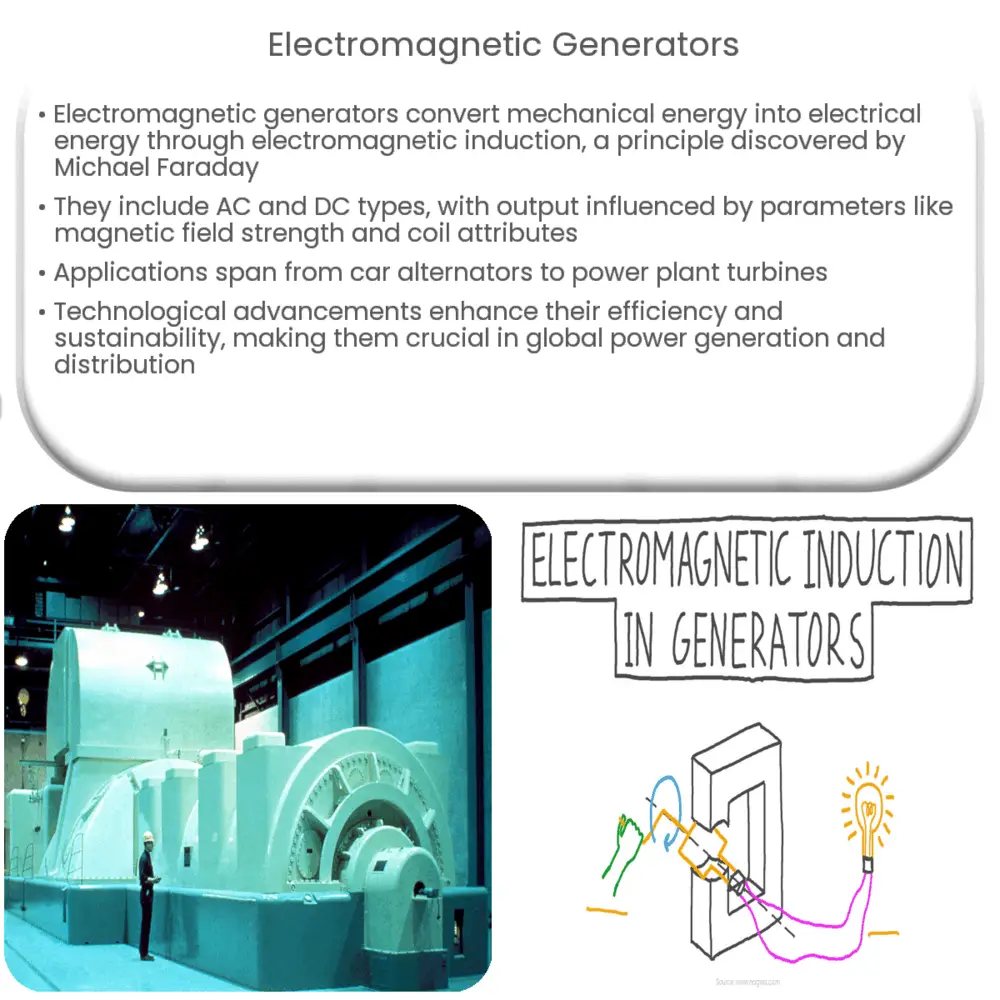Explore the workings, types, and applications of electromagnetic generators, from everyday systems to power grids. Learn how modern advancements shape our future.

Introduction to Electromagnetic Generators
An electromagnetic generator is a device that transforms mechanical energy into electrical energy. It operates based on the principles of electromagnetic induction, discovered by physicist Michael Faraday in 1831. Faraday’s law of electromagnetic induction is the fundamental principle underlying the operation of this pivotal device.
Working Principle of Electromagnetic Generators
The basic idea behind an electromagnetic generator is that the movement of a conductor, such as a wire, in a magnetic field induces an electrical current in the conductor. In simpler terms, when a coil of wire (also referred to as the armature) is rotated in a magnetic field, an electric current is generated in the wire.
The key components of an electromagnetic generator typically include a magnet (to create the magnetic field), an armature (a coil of wire), and a commutator. These essential elements work in unison to convert mechanical energy, typically derived from a prime mover like a diesel engine, water turbine or steam turbine, into electrical energy.
Types of Electromagnetic Generators
- Alternating Current (AC) Generators: Also known as alternators, these generators produce alternating current. This is the most common type of electricity used in homes and businesses around the world.
- Direct Current (DC) Generators: These generators produce direct current, a type of electricity that flows in a single direction. This is often used for devices that require a stable and continuous amount of voltage, such as batteries.
Key Parameters of Electromagnetic Generators
The output of an electromagnetic generator is influenced by a number of parameters. These include the strength of the magnetic field, the speed of the mechanical input (often represented as the speed of rotation of the armature), the number of turns in the coil, and the coil’s area. All these parameters, when adjusted appropriately, can influence the output voltage and current of the generator.
In the next part, we will delve deeper into the applications of electromagnetic generators, the science behind electromagnetic induction, and the modern advancements in generator technology.
Applications of Electromagnetic Generators
Electromagnetic generators have a broad array of applications across diverse sectors. They are integral to providing power in many everyday systems. For instance, in the automotive industry, car alternators are a type of electromagnetic generator that recharges the battery and powers the electrical system when the engine is running.
In the energy sector, large scale electromagnetic generators are used in power plants, including nuclear, fossil fuel, and hydroelectric facilities. These generators convert the mechanical energy produced by turbines into electrical energy that can be distributed across the power grid.
Science Behind Electromagnetic Induction
Electromagnetic induction, the principle behind electromagnetic generators, is a phenomenon in physics. It occurs when a conductor moves through a magnetic field, creating a flux change that induces an electromotive force (emf) in the conductor.
This principle was first discovered by Michael Faraday in 1831 and is mathematically represented by Faraday’s law of electromagnetic induction. It is this fundamental principle that enables the conversion of mechanical energy to electrical energy in a generator.
Modern Advancements in Generator Technology
With the advent of new technology and materials, electromagnetic generators have undergone significant evolution. The development of high-strength, lightweight magnets, the use of advanced materials in coil windings, and improvements in the design of generator parts have all contributed to increased efficiency, compactness, and durability of these machines.
Renewable energy technologies, like wind turbines and photovoltaic systems, have also leveraged advancements in generator technology, making sustainable power generation more viable and efficient.
Conclusion
In conclusion, electromagnetic generators play a crucial role in power generation and distribution across the globe. The principles of electromagnetic induction upon which they operate have facilitated a wide range of applications, from powering vehicles to supplying electricity to entire cities. Modern technological advancements continue to enhance their efficiency and sustainability, promising a bright future for this essential device. Understanding the underlying mechanics and the scope of electromagnetic generators can allow us to appreciate their impact on our daily lives and the broader energy sector.

